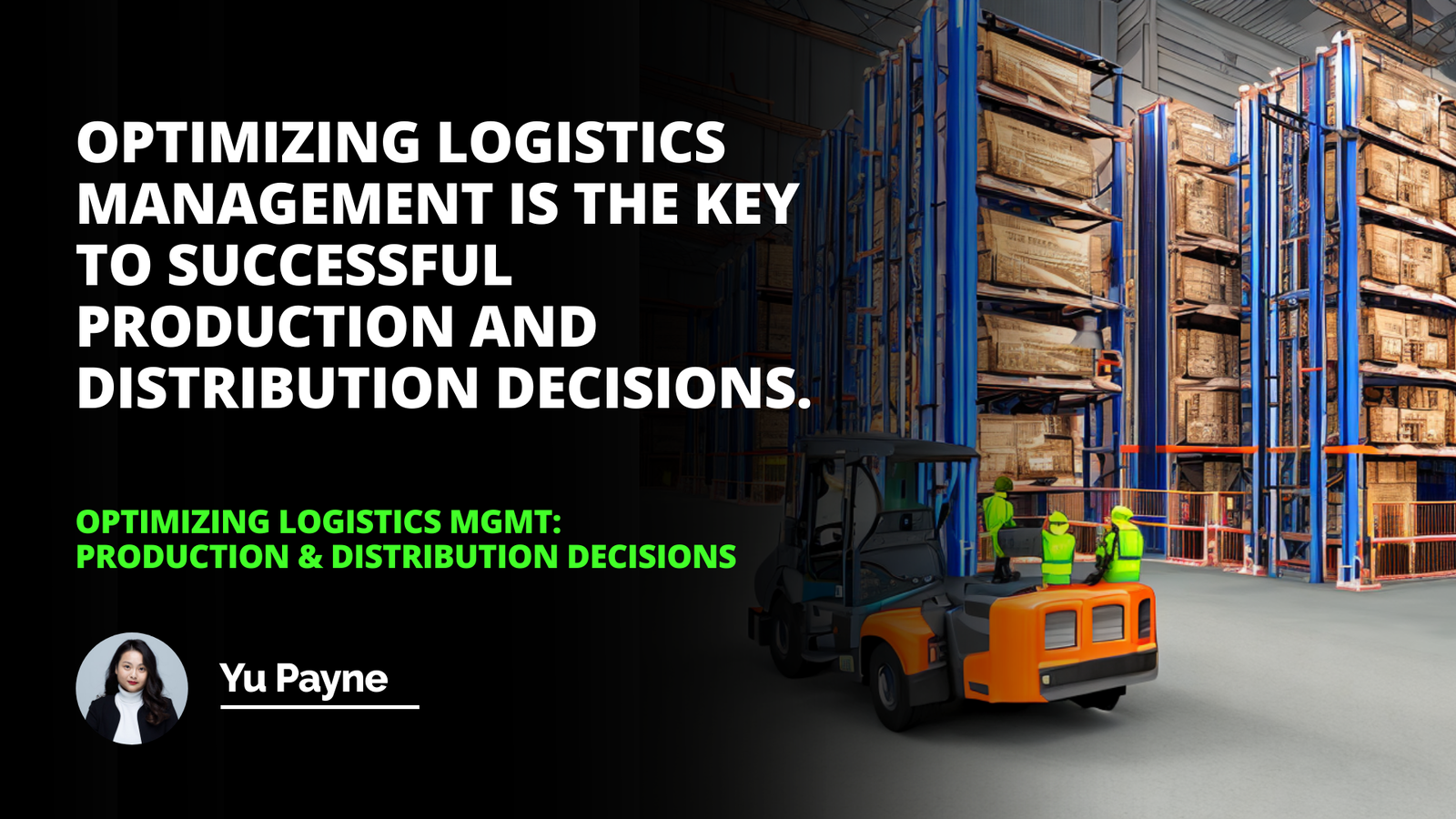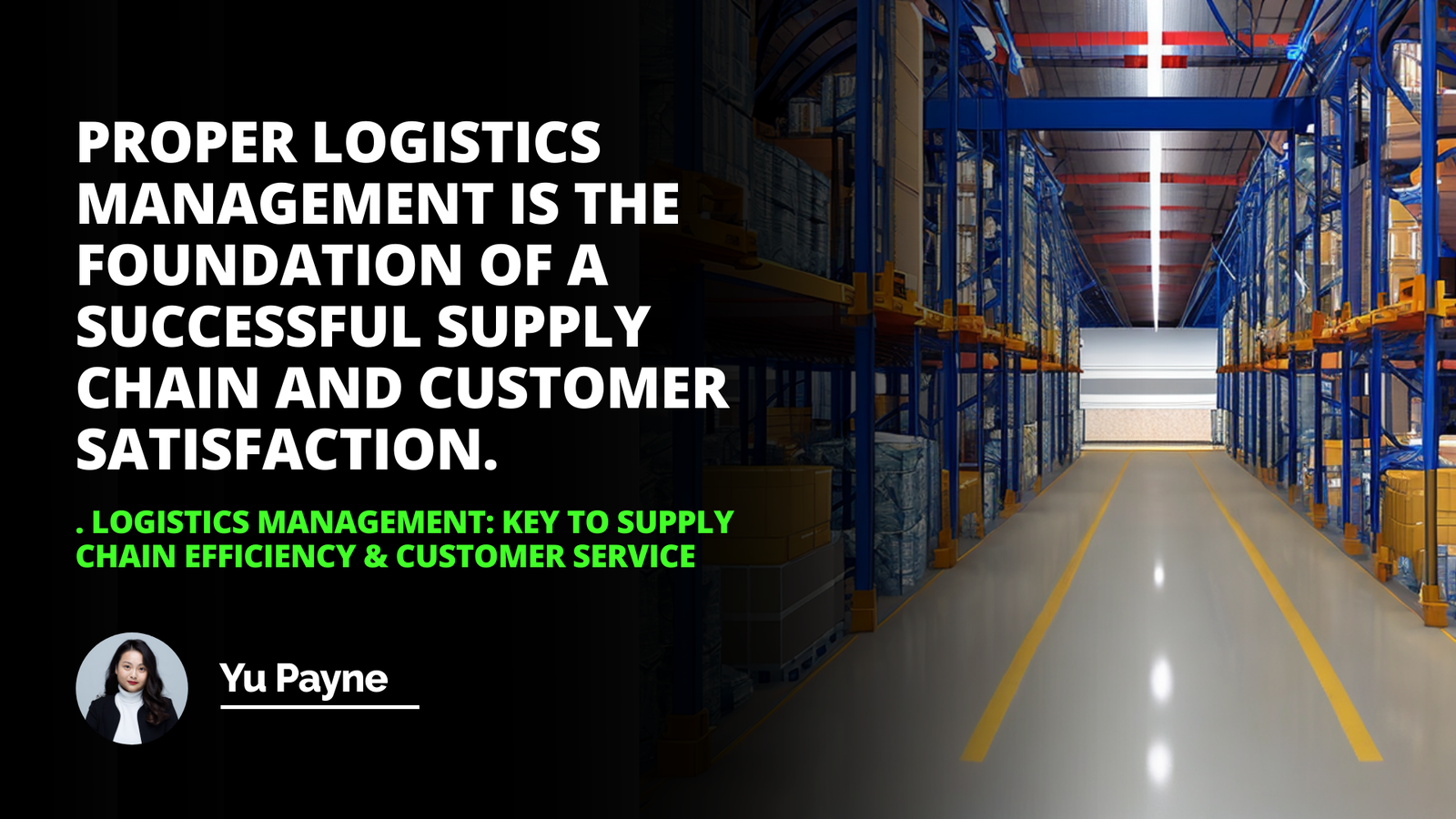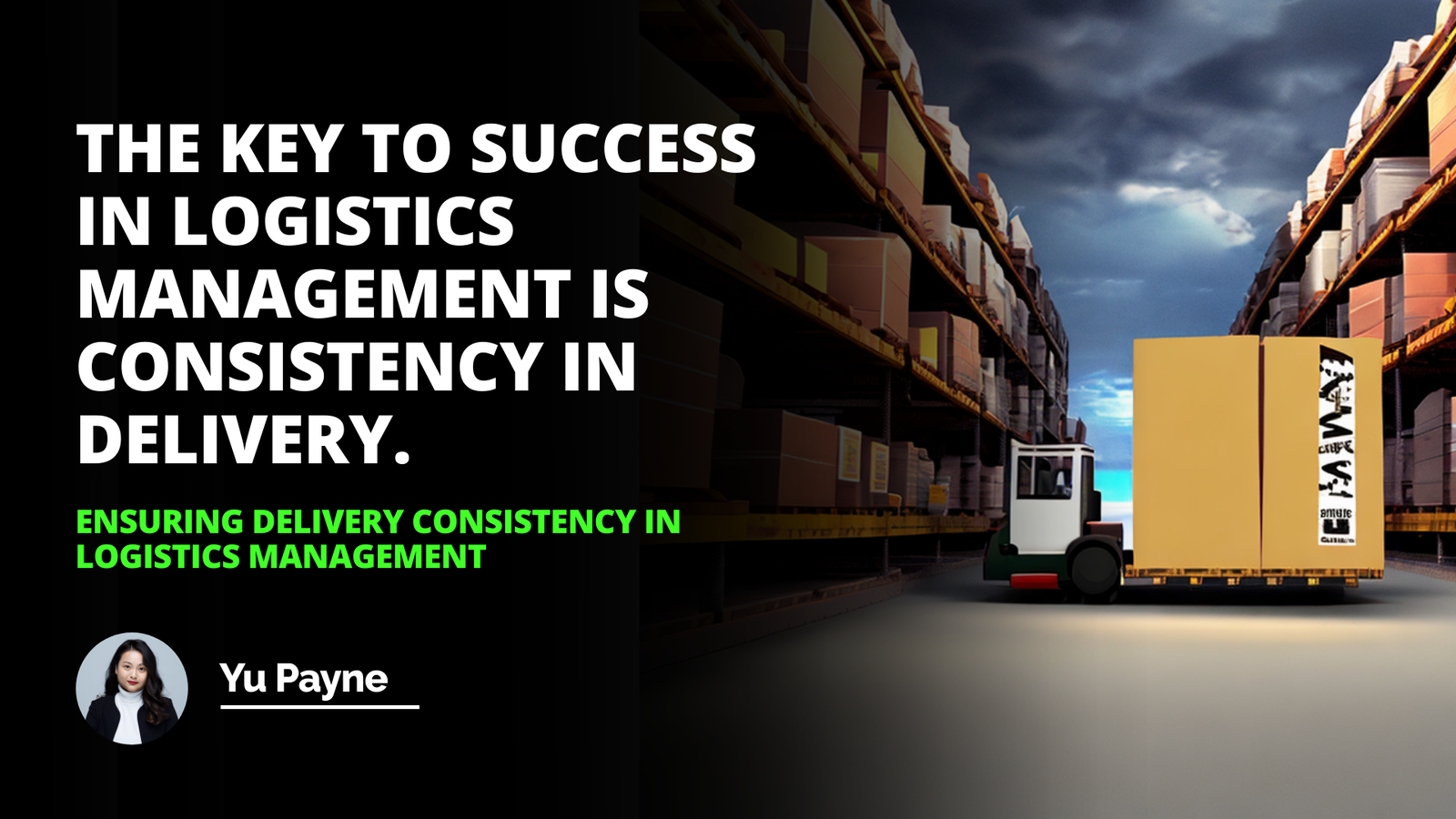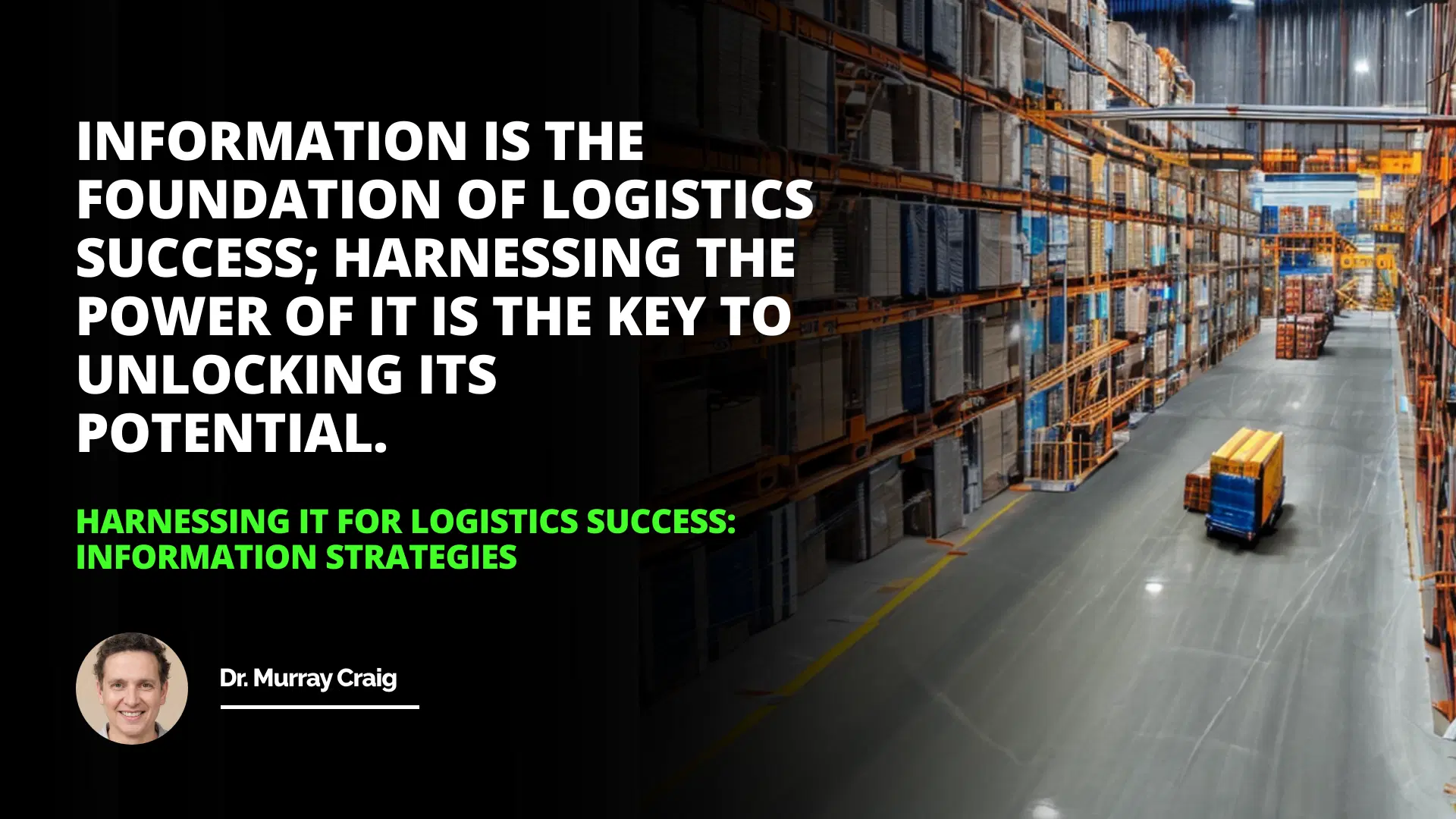
Embracing Information Technology in Logistics: A Personal Journey
Benefits of Employing Information Technology in Logistics
Challenges of Applying IT in Logistics
Strategies for Effectively Managing Logistics Through Information Technology
I still remember the days when my father ran a small logistics company out of our garage. Stacks of paper invoices, maps sprawled across the table, and a landline phone were his essential tools. Watching him juggle deliveries with such limited resources was nothing short of impressive. Fast forward to today, and the landscape of logistics has transformed dramatically, thanks in large part to information technology (IT).
The Evolution of Logistics in the Digital Age
As the world becomes more interconnected, businesses have an unprecedented opportunity to leverage IT to enhance their operations. This is especially true in logistics, where the efficient storing, transporting, and distributing of goods are paramount. The integration of IT into logistics isn't just a trend; it's a necessity for staying competitive in today's market.
Benefits of Employing Information Technology in Logistics
Improved Tracking and Visibility
One of the most significant advantages of incorporating IT into logistics is the enhanced tracking of goods. I recall a time when a shipment of essential medical supplies was delayed, causing a ripple effect of stress and anxiety. Nowadays, with technologies like GPS and advanced transport management systems, companies can pinpoint the exact location of their shipments in real-time.
This level of visibility not only improves customer satisfaction but also allows for proactive problem-solving. If a delay is anticipated due to unforeseen circumstances like weather or traffic, logistics managers can reroute deliveries to ensure timely arrivals. This agility was unthinkable in the days of my father's paper maps.
They should establish a reliable IT team to manage and maintain the technology. This team needs to understand the business’s specific needs and be able to find reliable and cost-effective solutions.
Business leaders should use automation to streamline their inventory management. Automation can make for quicker and more accurate operations, as well as cut down on human errors.
Businesses must employ measures to ensure the security of their information.
Enhanced Communication Between Stakeholders
Another tremendous benefit is the improvement in communication. The supply chain involves multiple stakeholders, from suppliers and manufacturers to distributors and retailers. IT facilitates seamless communication through platforms like email, instant messaging, and collaborative software. This real-time interaction ensures that everyone is on the same page, reducing misunderstandings and bottlenecks.
Information is the foundation of logistics success. Harnessing the power of IT is the key to unlocking its potential.
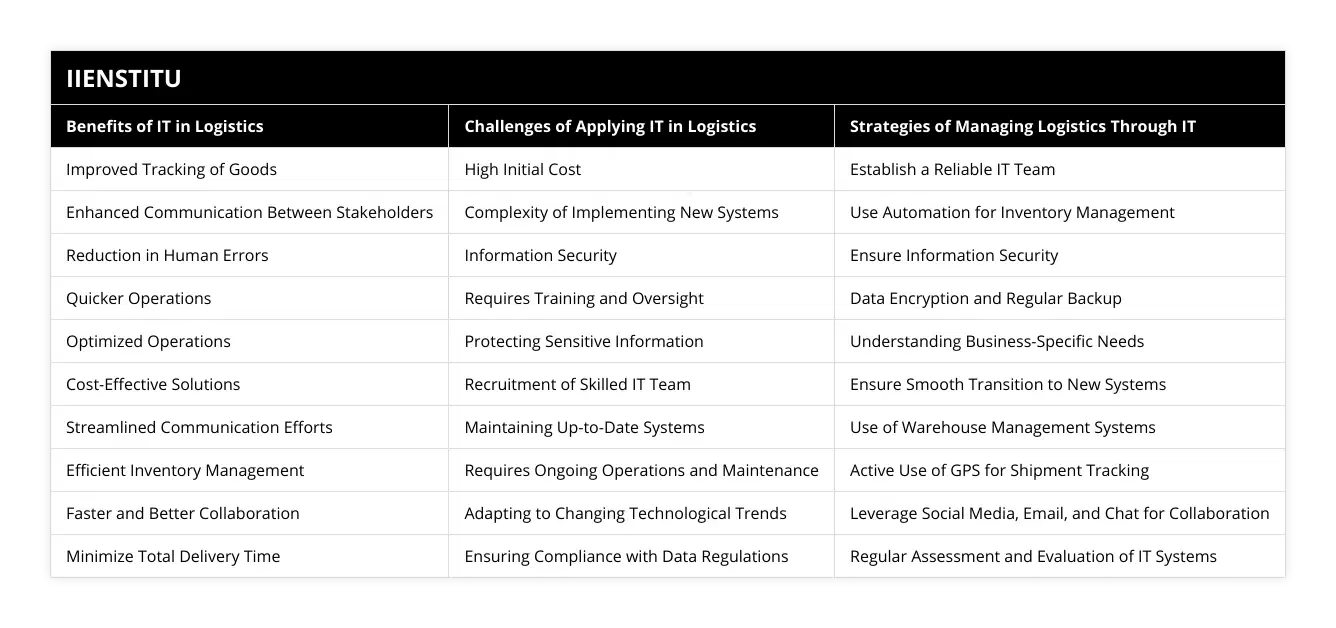
I once worked on a project where we implemented a supply chain management system that integrated all stakeholders. The difference was night and day. Errors decreased, efficiency improved, and we fostered stronger relationships across the board.
Automation and Efficiency
Automation is a game-changer in logistics. By automating repetitive tasks, companies can streamline their inventory management, reduce human error, and free up staff to focus on more strategic activities. For example, barcode scanning and RFID technologies have revolutionized warehouse management, making it faster and more accurate.
In my experience, implementing an automated warehouse management system led to a 30% increase in efficiency. Inventory discrepancies plummeted, and we could handle higher volumes without additional staff.
Challenges of Applying IT in Logistics
High Initial Costs
Despite the clear benefits, integrating IT into logistics doesn't come without challenges. The initial cost of implementing new technologies can be prohibitive, especially for small to medium-sized enterprises. Purchasing software licenses, upgrading hardware, and training staff require significant investment.
I remember pitching the idea of adopting a new transport management system to the board. The upfront costs made them hesitate. However, by presenting a detailed return on investment analysis, we demonstrated that the long-term savings and efficiencies would outweigh the initial expenditure.
Complexity and Training
Another hurdle is the complexity of new systems. Introducing advanced technologies can be overwhelming for staff accustomed to traditional methods. Proper training and change management are crucial to ensure a smooth transition.
In one instance, we rolled out a new supply chain management platform without adequate training. The result was confusion, frustration, and a temporary drop in productivity. We quickly learned our lesson and implemented a comprehensive training program, which made a world of difference.
Information Security Concerns
With greater reliance on IT comes the increased risk of cybersecurity threats. Protecting sensitive information is paramount. Data breaches can lead to financial losses, legal issues, and damage to a company's reputation.
We once faced a minor security breach that served as a wake-up call. From that point on, we prioritized data security by implementing robust encryption, regular security audits, and staff education on best practices.
Strategies for Effectively Managing Logistics Through Information Technology
To harness the full potential of IT in logistics, businesses need to adopt strategic approaches.
1. Establish a Reliable IT Team
Having a dedicated IT team is essential. They should understand the specific needs of the business and be capable of finding reliable and cost-effective solutions. This team's responsibilities include system maintenance, troubleshooting, and staying abreast of technological advancements.
In my current role, our IT team is the backbone of our operations. Their expertise allows us to implement new technologies smoothly and keep our systems running optimally.
2. Utilize Automation Wisely
Automation should be leveraged to streamline processes without compromising quality. Identify repetitive tasks that consume time and resources, and explore automation solutions for these areas.
For example, automated order processing can reduce errors and accelerate workflow. We implemented an automated invoicing system that cut down processing time by 50%.
3. Prioritize Information Security
Implementing robust security measures is non-negotiable. This includes encrypting data, regular backups, and employing firewalls and antivirus software. Regular training for staff on cybersecurity best practices is also vital.
We conduct quarterly security training sessions to keep all employees informed about potential threats and how to mitigate them. It's an investment that pays off by safeguarding our company's assets and reputation.
Personal Reflections on Embracing IT in Logistics
Looking back, the journey of integrating IT into logistics has been both challenging and rewarding. There were moments of doubt, especially when facing steep learning curves or tight budgets. However, the benefits have far outweighed the obstacles.
I recall a time when we were struggling with managing our fleet efficiently. Routes were planned manually, leading to inefficiencies and higher fuel costs. By adopting a transport management system, we optimized our routes, saving time and money.
Moreover, the ability to provide customers with real-time tracking information has enhanced trust and satisfaction. There's nothing quite like receiving a thank-you note from a client who appreciated the transparency and reliability of our service.
The Role of IT in Supply Chain Management
IT doesn't just revolutionize logistics; it transforms the entire supply and chain. By fostering better communication and coordination, IT enables supply chain departments to function more cohesively.
For example, the use of supply chain mgmt software allows for better demand forecasting, inventory management, and supplier relations. It's about creating a seamless flow from raw materials to the end consumer.
In our company, integrating IT into our management chain supply processes has led to significant improvements. We can now anticipate demand trends and adjust our procurement accordingly, reducing waste and increasing profitability.
Future Trends in Logistics IT
As technology continues to evolve, so too will its applications in logistics. Emerging technologies like Artificial Intelligence (AI), Internet of Things (IoT), and Blockchain are set to further transform the industry.
AI and Machine Learning: These technologies can improve predictive analytics, helping companies forecast demand and optimize routes.
IoT Devices: Sensors and connected devices enable real-time monitoring of assets, ensuring better maintenance and reducing downtime.
Blockchain Technology: Enhances transparency and security in transactions, which is crucial for trust among supply chain partners.
Embracing these technologies will be essential for companies aiming to remain competitive.
Conclusion: Unlocking the Full Potential of IT in Logistics
Integrating information technology into logistics is no longer optional; it's a strategic imperative. The benefits of improved tracking, enhanced communication, and increased efficiency are too significant to ignore. While challenges like cost, complexity, and security concerns exist, they can be mitigated with the right strategies.
Establishing a reliable IT team, wisely utilizing automation, and prioritizing security are critical steps. By doing so, businesses can unlock the full potential of IT, optimizing their operations and gaining a competitive edge.
As I reflect on my journey from watching my father manage logistics with minimal technology to now leveraging advanced systems, I am amazed at how far we've come. Information is indeed the foundation of logistics success, and harnessing the power of IT is the key to unlocking its potential.
References
Chopra, S., & Meindl, P. (2016). Supply Chain Management: Strategy, Planning, and Operation. Pearson.
Rushton, A., Croucher, P., & Baker, P. (2017). The Handbook of Logistics and Distribution Management. Kogan Page Publishers.
Grant, D. B., Trautrims, A., & Wong, C. Y. (2017). Sustainable Logistics and Supply Chain Management. Kogan Page Publishers.
Frequently Asked Questions
What are the Benefits of Harnessing IT for Logistics Success?
In this digital age, Information Technology (IT) usage in logistics is increasingly critical for a successful operation. Companies must invest in IT and take advantage of its multiple benefits to ensure their survival in an ever-competitive market, improve their services, reduce costs, and achieve overall financial success. This article will discuss the key benefits of harnessing IT for logistics success.
The first advantage of using IT is improved customer relations. With IT, companies can communicate better with their customers while monitoring their orders and shipments, providing them with up-to-date information in real time. In addition, through the proper use of certain apps and tools, companies can track their customers’ and partners’ performance, receiving feedback from them in a much faster and more organized way. Automated systems and artificial intelligence solutions, allied with customers’ data, also empower businesses to offer customers the best products, services, and customized solutions that keep them happy and potentially increase customer retention.
Another great benefit of IT for logistics success is improved operational efficiency and productivity. Companies can monitor their supply chains and workflows, allowing them to better understand their customers’ actions and increase efficiency by saving time and reducing costs. With IT, businesses can automatically plan routes, schedule deliveries, track shipments, and forecast demands. They can also implement automated processes, reducing human error and providing their team with insights and quick corrective measures.
Finally, IT helps logistics companies optimize resources and performance by leveraging automation, analytics, and Machine Learning (ML) solutions. AI solutions are becoming increasingly important in the logistics industry, enabling companies to acquire greater visibility into their operations and uncover valuable insights. By using AI, businesses can make better decisions, diagnose potential problems, and set realistic goals. Moreover, AI solutions are also more cost-effective than other manual solutions. They can improve their responses, thereby increasing agility and efficiency.
Companies should invest in IT and leverage its benefits for success in the logistics industry. It helps companies improve customer relations, increase operational efficiency, and optimize resources and performance. By successfully harnessing IT, organizations can reduce costs, maximize profits, and achieve overall success.

What Strategies are Most Effective for Harnessing IT in Logistics?
The utilization of Information Technology (IT) has had a dramatic and positive impact on the logistics sector for many years. It is an integral part of efficient and effective logistics management. IT systems can allow for improved collaboration and communication across the warehouse, increased shipping accuracy, and cost savings. Many organizations recognize the benefits of harnessing IT in logistics. However, practical strategies for understanding and implementation still need to be developed. In this article, we will discuss different strategies for harnessing IT in logistics and the benefits of each approach.
One effective strategy for harnessing IT in logistics is to utilize user profiles. User profiles allow the organization to track the interaction of different departments and individuals with IT systems. This information can be used to create 'personas' of each department, detailing their current technical aptitude, usage of specific applications and databases, and projected IT needs in the future. Knowing these details allows for increased system flexibility, smoother workflow, and improved identification of gaps in the procedure.
Another critical strategy for harnessing IT in logistics is automation. Automation requires the implementation of Digital Shopping (DS) and/or Radio Frequency Identification (RFID) systems. With DS systems, inventory details, order statuses, and customer information can be tracked and recorded more quickly and accurately. Similarly, RFID systems allow for more efficient warehouse operations by enabling inventory tracking throughout the supply chain process. Automation increases inventory accuracy and cost savings, allowing for more open collaboration and communication between the warehouse, distribution center, and customers.
Lastly, embracing emerging technology is one of the most effective strategies for harnessing IT in logistics. Technologies such as Blockchain, Augmented/Virtual Reality (AR/VR), and Artificial Intelligence (AI) create a platform for improved information sharing and automation. For example, blockchain technology allows instantaneous data transfer and improved transparency within the supply chain system. At the same time, AR and VR enable better collaboration across numerous departments. AI systems can also provide predictive analytics tailored to the organization's needs, allowing for improved forecasting and cost optimization.
In summary, practical strategies for harnessing IT in logistics include utilizing user profiles, implementing automation, and embracing emerging technologies such as Blockchain, AI, and AR/VR. These strategies can offer improved accuracy, cost savings, and increased collaboration, helping organizations to remain competitive in the rapidly changing logistics landscape.
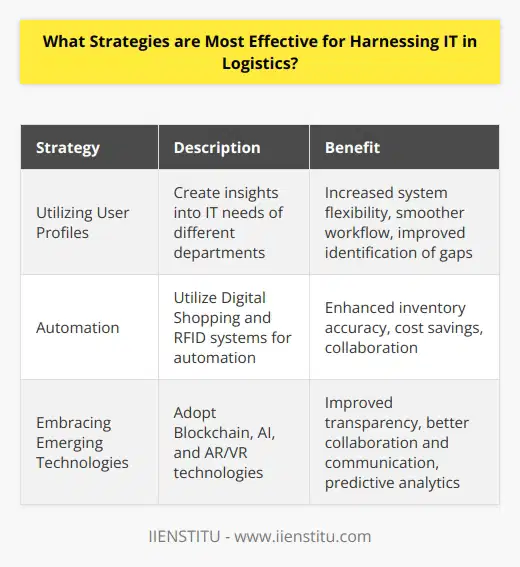
What Factors Should be Considered before Implementing IT for Logistics Solutions?
Information Technology (IT) has become increasingly crucial for logistics solutions in the transportation industry. However, while utilizing IT for logistics solutions can improve operations and efficiency, several factors must be considered before implementing such technology.
First and foremost, the company must ensure that necessary resources are available for IT implementation. This includes ensuring the required IT infrastructure, technical staff, and financial budget are present. Additionally, the company should have sufficient customer data to provide the IT implementation that is applicable and appropriate for the specific transportation needs.
Second, the company should consider the types of logistic services with which the IT will be used. It can be used for many logistics services, such as route planning, freight tracking and monitoring, and customer relationship management. Depending on the types of services needed, different types of IT may be necessary.
Third, companies implementing IT for logistics solutions should consider the various readily available and applicable technologies. The company should seek reliable, cost-effective, and efficient technologies that can easily integrate into the existing IT infrastructure.
Finally, and most importantly, the company must assess its customer's needs and preferences before implementing IT for logistic solutions. The technology must meet the customer's requirements to ensure satisfied customers. This involves understanding the customer's needs regarding storage and delivery, transportation services, and other logistics services.
In conclusion, several factors must be considered before implementing IT for logistics solutions. Companies should ensure access to the necessary resources, consider the type of logistic services with which the IT will be used, assess the available technologies, and analyze customers' needs and preferences.
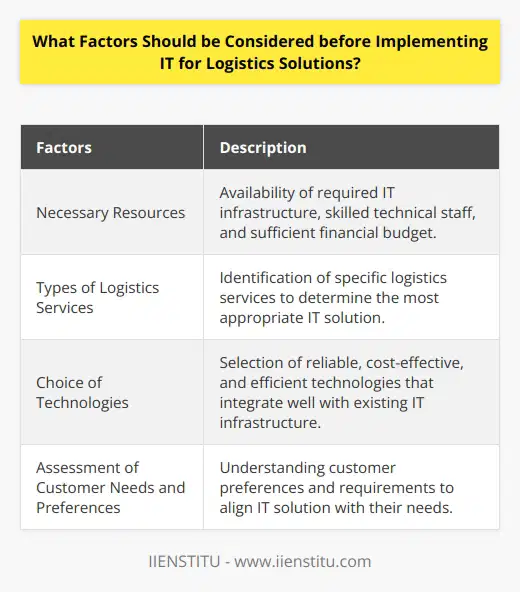
What are the key components of a successful logistic strategy?
**Logistics Strategy Essentials**
A successful logistics strategy encompasses several key components, which together enable companies to seamlessly manage their supply chain operations, reduce costs, and increase customer satisfaction. These integral elements can be broadly categorized into the following subheadings:
**Effective Transportation Management**
Transportation management is vital in ensuring products are delivered on time, within budget, and in good condition. Consequently, it entails selecting the most appropriate transportation modes, optimizing routing, and collaborating with trusted, reliable partners to achieve these goals.
**Robust Inventory Control**
Efficient inventory control includes striking the right balance between having ample stock to meet customer demand and minimizing excessive, costly inventory holding. Therefore, advanced forecasting techniques, safety stock planning, and timely replenishment processes form the backbone of robust inventory management systems.
**Seamless Information Exchange**
Transparent communication and seamless information exchange between various supply chain partners are crucial for effective coordination and decision-making. Employing an integrated management system, such as an Enterprise Resource Planning (ERP) tool, is essential to aggregate relevant data and promote real-time collaboration across organizational functions and stakeholders.
**Cost Management and Optimization**
Streamlining supply chain processes and mitigating unnecessary expenses contributes significantly to a successful logistics strategy. By analyzing cost drivers, identifying inefficiencies, and implementing lean management techniques, companies can achieve optimal cost performance and remain competitive in their respective markets.
**Compliance with Regulations**
Adhering to various trade and transportation regulations is of paramount importance in maintaining a company's reputation and avoiding legal issues. A strong logistics strategy entails understanding such regulatory requirements, complying with them, and staying updated with any changes or developments.
**Continuous Improvement**
Lastly, a commitment to continuous improvement is necessary for long-term success in logistics. This involves identifying potential areas for enhancement, tracking and monitoring key performance indicators (KPIs), and refining logistics processes and systems through continuous learning and development. By prioritizing these strategic components, companies can create a robust logistics framework that drives performance, customer satisfaction, and overall profitability.
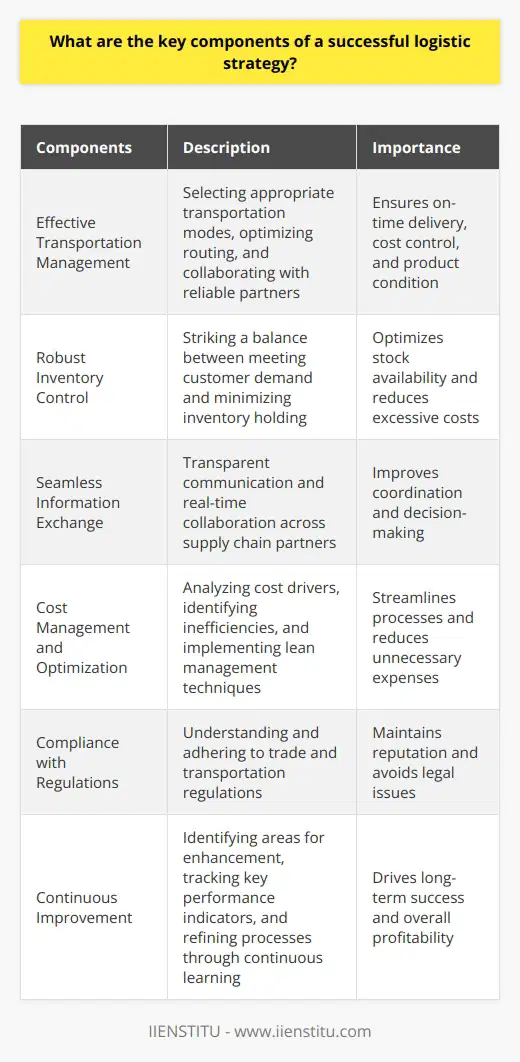
How do collaborative relationships among supply chain partners impact logistics management?
Impact on Efficiency and Coordination
Collaborative relationships among supply chain partners significantly impact logistics management by increasing efficiency and coordination. When organizations effectively communicate and share information, they can better align their objectives and streamline their operations. This ultimately leads to reduced lead times, improved customer service, and minimized operational costs.
Enhanced Decision-Making Processes
In addition, collaboration enables supply chain partners to access and analyze data collectively, enhancing the decision-making process. With a deeper understanding of each partner's capabilities and constraints, organizations can make informed decisions related to inventory management, transportation, and production scheduling. This information-sharing fosters agility and responsiveness, contributing to operational excellence and competitive advantage.
Risk Mitigation and Management
A collaborative supply chain also enables partners to identify and mitigate risks effectively. By pooling resources and sharing intelligence, organizations can proactively address potential disruptions, such as supplier failure, transportation delays, or fluctuating demand. This shared risk management approach strengthens the overall supply chain resilience, ensuring business continuity and minimizing the impact of unforeseen incidents.
Strengthening Innovation and Competitiveness
Collaborative relationships drive innovation and competitiveness in the supply chain by promoting knowledge exchange and fostering a culture of continuous improvement. Through close collaboration, partners can identify opportunities for process enhancement, cost reduction, and product innovation. Additionally, collaboration allows smaller organizations to leverage the capabilities of their larger partners, enabling them to compete more effectively in the marketplace.
Improved Sustainability and Corporate Social Responsibility
Finally, collaboration among supply chain partners can lead to improvements in sustainability and corporate social responsibility. By working together, organizations can develop strategies to reduce their environmental impact, ensure ethical sourcing, and support local communities. This collaborative approach to sustainability can enhance an organization's reputation, increase consumer trust, and support long-term business success.
In conclusion, collaborative relationships among supply chain partners play a critical role in logistics management by improving efficiency, coordination, decision-making, risk management, innovation, and sustainability. These benefits not only enhance operational performance but also contribute to overall business success and competitiveness in an increasingly globalized and interconnected world.
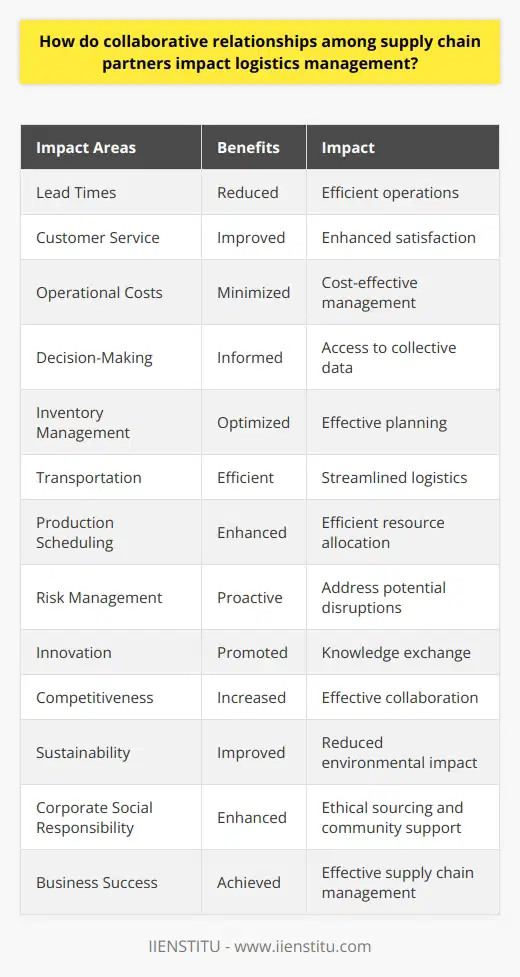
What role does technology play in enhancing the efficiency of logistics operations?
Role of Technology in Logistics Operations
Enhancing Decision-Making
Technology significantly improves the efficiency of logistics operations by enabling swift, data-driven decision-making. Real-time data analytics informs logistics managers about crucial factors such as demand forecasting, route optimization, and inventory management. These insights help in making informed decisions, leading to efficient logistics operations.
Streamlining Communication
Effective communication is pivotal in logistics operations. Technology, through communication software and tools, facilitates seamless communication between various stakeholders, such as suppliers, customers, and employees. This connectivity creates a cohesive logistics network, minimizing delays and errors while increasing efficiency in supply chain management.
Increasing Automation and Integration
Integration of automation technologies, such as robotics and artificial intelligence (AI), accelerates the warehouse management system's efficiency by reducing manual labor and human error. Automated systems accurately pick, pack, and process orders, thus speeding up operational workflows. These technologies contribute to the overall efficiency of logistics operations.
Enhancing Transportation Management
Technology, through transport management systems, aids in route planning and vehicle tracking, reducing transit times, and minimizing fuel consumption. GPS-enabled devices allow logistics managers to monitor fleet movement and make informed decisions about route adjustments, leading to efficient transportation management.
Improving Visibility and Transparency
Advancements in technology, such as IoT sensors and real-time tracking systems, provide better visibility into supply chain processes. This accessibility enables proactive management of inventory, order fulfillment, and transportation, significantly reducing costs and errors. Enhanced visibility and transparency result in more efficient and responsive logistics operations.
Optimizing Resource Utilization
Technology simplifies resource allocation, ensuring optimal usage of available resources. Resource management software helps logistics operators plan workflows, workforce, and equipment cost-effectively. Moreover, technology contributes to reducing waste and promotes sustainable practices, leading to efficient logistics operations.
In conclusion, technology plays a critical role in enhancing the efficiency of logistics operations by enabling informed decision-making, streamlining communication, increasing automation, and providing visibility into the supply chain. By utilizing advanced technologies such as AI, IoT, and data analytics, logistics companies can significantly improve their performance and profitability.
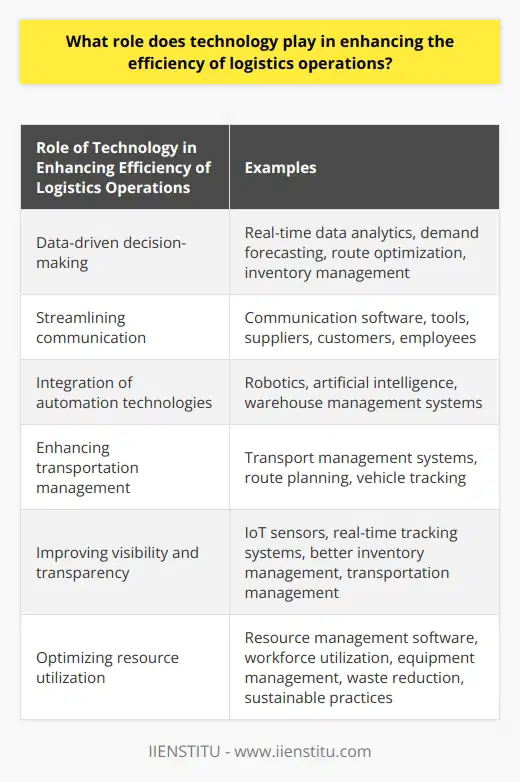
What are the 5 logistics strategies?
Logistics Strategies Overview
Logistics strategies are essential in the efficient management of the supply chain, enhancing a company's competitive advantage. Five critical logistics strategies include just-in-time, lean logistics, agile logistics, postponement, and mass customization. These strategies enable organizations to streamline their processes, reduce costs, improve customer satisfaction, and ultimately drive growth.
Just-in-Time Approach
The just-in-time (JIT) strategy focuses on reducing inventory carrying costs by producing and delivering products as needed. This approach ensures that inventory levels are minimal, and waste is reduced. JIT requires close coordination between suppliers, manufacturers, and customers to execute the production process efficiently and effectively.
Lean Logistics Strategy
The lean logistics strategy aims to remove non-value-adding steps within the supply chain, thereby reducing costs and improving efficiency. This strategy involves continuous analysis and improvement of the logistics process to minimize waste, improve quality, and increase customer satisfaction. Lean logistics require strong management, effective communication, and ongoing assessment of the supply chain's effectiveness.
Agile Logistics Strategy
Agile logistics is centered on responsiveness and flexibility, allowing a company to adjust quickly to changes in demand, market conditions, and customer needs. This strategy focuses on using real-time data and effective communication channels to make prompt decisions and address potential issues within the supply chain. Agile logistics empowers organizations to remain competitive in dynamic business environments.
Postponement Strategy
Postponement involves delaying product customization or final assembly until customer orders are received. This strategy allows organizations to maintain inventory in a generic form, reducing overall inventory costs and minimizing the risk of obsolescence. Postponement enables companies to respond swiftly to changes in preferences or demand, ensuring that products align with the customer's wants and needs.
Mass Customization Strategy
Mass customization is a logistics strategy that focuses on producing highly customized products while maintaining the efficiency of large-scale production. This approach relies on advanced production techniques, technology, and effective information exchange between the company and its suppliers. Mass customization enables organizations to cater to individual customer preferences while still benefiting from economies of scale.
In conclusion, logistics strategies play a vital role in the management of the supply chain, providing companies with a competitive edge in the market. Understanding the advantages and applicability of these strategies enables organizations to make informed decisions, optimize their supply chain, and remain responsive to the constantly changing business landscape.
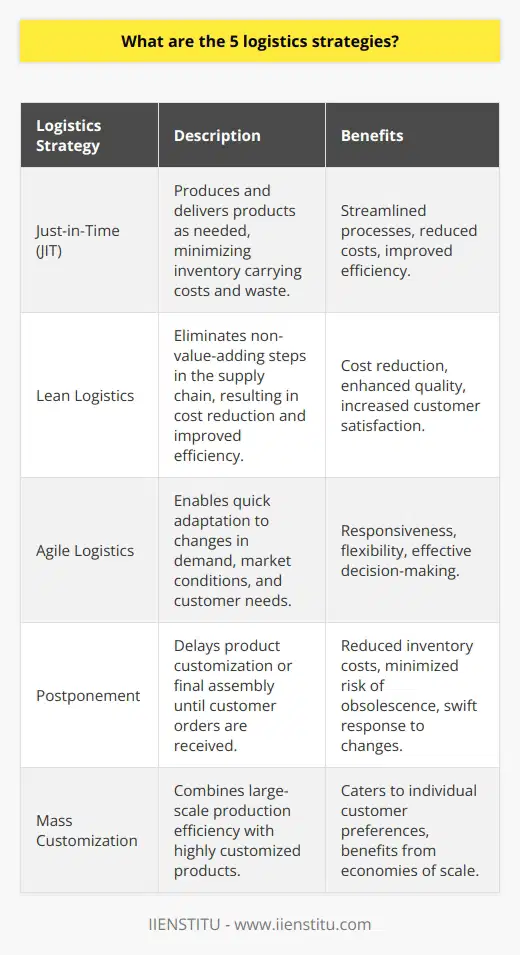
What are the ways to improve information flow in logistics?
Enhancing Connectivity and Collaboration:
One way to improve information flow in logistics is by enhancing connectivity and collaboration among supply chain partners. This can be achieved through the implementation of cloud-based technologies and platforms that allow real-time access to data and facilitate seamless communication. Implementing unified communication systems, such as video conferencing and instant messaging, can further streamline collaboration and decision-making processes among partners.
Investing in Advanced Technologies:
Another method to improve information flow is the investment in advanced technologies that efficiently and effectively gather, analyze, and disseminate information. Radio frequency identification (RFID) technology, for example, can provide real-time visibility of product movements throughout the supply chain. Machine learning and artificial intelligence (AI) can also be employed to automatically analyze data, generate insights, and take corrective action when needed.
Employing Standardized Data Formats:
Standardized data formats can significantly improve information flow by ensuring that all supply chain partners can easily interpret and share data. This can be achieved by embracing widely accepted data formats, such as Electronic Data Interchange (EDI) and Extensible Markup Language (XML), which facilitate data interchange among partners. In addition, companies should establish internal data governance policies to ensure data consistency and accuracy.
Adopting Real-Time Data Collection:
Adoption of real-time data collection tools and technologies can greatly improve information flow in a logistics environment. By collecting data in real time, companies can make faster and better-informed decisions. Internet of Things (IoT) devices and sensors, for example, can continuously track and transmit essential information, such as vehicle location and cargo temperature, enabling companies to react promptly to any issues that may arise.
Outsourcing Data Management:
Lastly, companies can consider outsourcing data management activities to third-party logistics (3PL) providers. These providers are experts at collecting and managing data, which allows businesses to focus on their core competencies. Outsourcing data management can not only improve data quality and accuracy, but also help companies gain access to cutting-edge technologies and expertise that can improve information flow and overall logistics performance.
In conclusion, improving information flow in logistics can be achieved through the adoption of advanced technologies, data standardization, real-time data collection, and outsourcing data management activities. Fostering greater connectivity and collaboration among supply chain partners will further enhance information flow, resulting in more efficient decision-making and improved logistics performance.
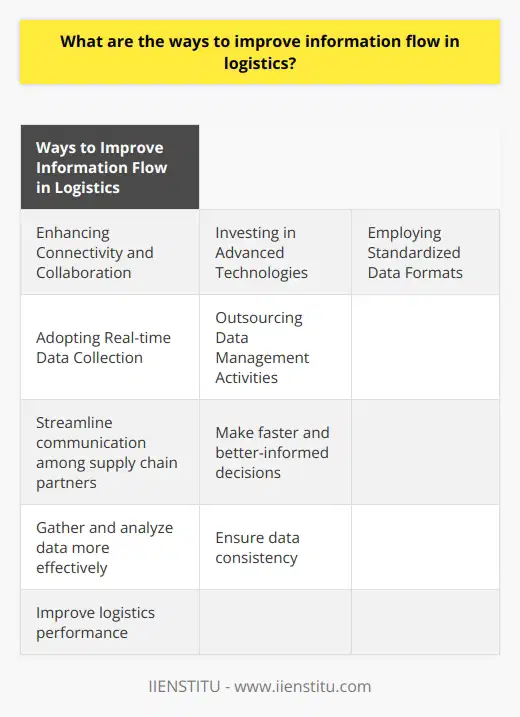
What are effective logistics management strategies?
Efficient Transport and Storage Solutions
One essential strategy for effective logistics management is utilizing efficient transport and storage solutions. By optimizing transportation routes, companies can reduce transportation costs, fuel consumption, and transit times, leading to increased overall efficiency. In addition, organizations should consider implementing a Warehouse Management System (WMS) that allows for real-time tracking of inventory, thereby improving accuracy and reducing the potential for stockouts or overstock situations.
Integration of Various Logistics Functions
Effective logistics management requires the integration of various functions within the supply chain, such as procurement, warehousing, transportation, and customer service. By fostering a collaborative environment, organizations can facilitate information exchange, ensuring that all stakeholders are aware of any changes or issues and can promptly respond. This collaborative approach promotes greater visibility, decision-making capabilities, and overall efficiency throughout the logistics process.
Adoption of Technology and Automation
The implementation of technology and automation is another key strategy for effective logistics management. Advanced tracking systems, for example, can offer real-time updates on shipment status, enabling companies to react quickly to any discrepancies. Additionally, utilizing warehouse automation and robotics can improve storage capacity and retrieval speed while reducing manual labor costs. The adoption of these technologies can significantly enhance the efficiency and reliability of logistics operations, thus improving overall supply chain performance.
Sustainability Initiatives
Sustainable logistics management practices are increasingly crucial for gaining a competitive advantage, as consumers and corporate partners alike are becoming more environmentally conscious. Implementing eco-friendly strategies, such as reducing packaging materials, optimizing routes to minimize fuel consumption, and utilizing renewable energy sources for warehouses, can contribute to a greener supply chain. These sustainability initiatives not only reduce the environmental footprint of logistics operations but can also lead to significant cost savings in the long term.
Continuous Improvement and Performance Evaluation
Lastly, companies should continually assess their logistics management practices to identify areas for improvement. By evaluating key performance indicators (KPIs), organizations can gain a clear understanding of the efficiency and effectiveness of their logistics processes. Regular performance reviews enable companies to pinpoint bottlenecks, enhance customer satisfaction, and ensure that logistics strategies remain aligned with overall business objectives. This commitment to continuous improvement ensures that logistics management strategies remain optimized and effective over time.

What makes a successful strategy in logistics?
Key Components of a Successful Logistics Strategy
Efficient Planning
A successful strategy in logistics begins with efficient planning, which involves analyzing the entire supply chain with a critical eye. This ensures optimal resource allocation and coordination between different stages in the process, leading to reduced operating costs and improved efficiency.
Adaptability
In a fast-paced and dynamic industry like logistics, adaptability is crucial for success. A successful logistics strategy must be flexible enough to account for unexpected changes and disruptions, such as fluctuations in demand, new competitors, or technological advancements. This adaptability enables businesses to respond effectively to changes, maintain their competitive edge, and capitalize on emerging opportunities.
Integration of Technology
The integration of technology plays a pivotal role in modern logistics strategies. Technologies such as warehouse management systems, transportation management systems, and data analysis tools enable businesses to optimize their operations, streamline processes, and make data-driven decisions. Consequently, the effective utilization of technology can propel a logistics strategy towards success by increasing efficiency, reducing human error, and enhancing overall supply chain transparency.
Collaboration
Successful logistics strategies embrace collaboration across the entire supply chain, from suppliers and carriers to customers and other stakeholders. Strong partnerships and open communication channels facilitate information sharing, joint problem-solving, and continuous improvement efforts. Collaboration leads to better decision-making, higher productivity, and ultimately, a more efficient and effective logistics operation.
Continuous Improvement
Lastly, a successful logistics strategy must prioritize continuous improvement, as it is essential in maintaining a competitive advantage in the ever-evolving logistics landscape. Through regular performance monitoring, performance measurement, and benchmarking, businesses can identify areas for improvement and develop targeted strategies to address these issues. This continuous process of evaluation and adjustment keeps the logistics strategy adaptable, efficient, and primed for success.
In conclusion, a successful strategy in logistics entails efficient planning, adaptability, integration of technology, collaboration, and continuous improvement. These key components enable businesses to optimize their operations, remain competitive, and respond effectively to changes in the ever-evolving logistics landscape.

What are the 7 R's for better logistics management?
**Understanding the 7 R's**
For effective logistics management, it is crucial to understand and implement the 7 R's. These essential components ensure a smooth operational flow and better coordination among supply chain partners.
**Right Product**
Choosing the right product is critical, as it directly affects customer satisfaction. A well-researched product selection process aids in meeting consumer demands and contributes to business growth.
**Right Quantity**
The right quantity of products ensures a balance between overstocking and understocking. Accurate forecasting and inventory management prevent stockouts, improve customer satisfaction, and optimize storage costs.
**Right Condition**
Supply chain managers must ensure that products maintain their intended condition throughout transportation and storage. Proper packaging, handling, and cold-chain management preserve product quality, reducing the risk of returns and customer complaints.
**Right Place**
Efficient logistics management entails delivering products to the correct destination. This accuracy requires thorough planning and clear communication with transportation providers, drivers, and customers to avoid delays and misdeliveries.
**Right Time**
Timely delivery of products is essential for businesses, as it directly impacts customer satisfaction and loyalty. Logistics managers must carefully schedule and monitor shipment progress to ensure punctual deliveries.
**Right Cost**
Effective cost management is pivotal for logistics operations. Managers must continuously explore cost-saving methods without sacrificing product quality or customer service. Identifying areas of improvement, negotiating with suppliers, and optimizing routes can contribute to reduced logistics expenses.
**Right Customer**
Lastly, targeting the right customer base is crucial to supply chain success. Thorough market research, demographic analysis, and competitive assessment enable companies to focus on their most profitable customer segments.
In conclusion, integrating the 7 R's in logistics management fosters a more efficient and customer-oriented supply chain. By continuously evaluating and refining these aspects, companies can achieve long-term viability and growth in a competitive market.

What strategies are used for logistics management?
Effective Logistics Management Strategies
Demand Forecasting
One essential strategy for managing logistics is demand forecasting. Accurate demand forecasts help companies determine optimal inventory levels, identify potential product shortages or surpluses, and make informed decisions about production scheduling.
Inventory Management
Effective inventory management is crucial in logistics management. By monitoring and controlling inventory levels, businesses can reduce excess stock, avoid stockouts, minimize lead times, and optimize storage space utilization.
Transportation Planning
Efficient transportation planning ensures timely delivery of products to customers while minimizing costs. This may include route optimization, selecting the most efficient transportation modes, and consolidating shipments when possible.
Supplier Collaboration
Collaborating with suppliers is vital for efficient logistics management. By establishing long-term partnerships, businesses can negotiate better prices and contracts, share valuable data, and work together to solve potential supply chain challenges.
Warehouse Management
Effective warehouse management, including organized storage and efficient picking and packing processes, can significantly reduce order fulfillment time and improve overall efficiency. This strategy encompasses the use of technology, such as warehouse management systems, to automate and streamline operations.
Technology Integration
Integrating technology across the entire supply chain can vastly improve logistics management. The use of software and systems, such as enterprise resource planning (ERP) and transportation management systems (TMS), enables real-time visibility, data analysis, and process automation for better decision-making.
Continuous Improvement
Finally, continuous improvement is an essential element of logistics management. Companies should consistently evaluate and refine their supply chain processes, identify areas for improvement, and implement strategies to increase efficiency and reduce costs.

What are the key factors influencing the development of a logistics strategy?
Determining Key Elements in Logistics Strategy Development
Identifying Business Goals
The first factor that influences the development of a logistics strategy is a clear understanding of the organization's overall business objectives. Companies must know their short and long-term goals to ensure that the logistics plan aligns with the intended direction for the enterprise.
Evaluating Customer Needs
Customer requirements significantly influence logistics strategies. Organizations must understand their clients' wants and needs to design logistics processes and services that meet and exceed expectations. Consideration of delivery speed, order accuracy, flexibility, and communication plays a crucial role in shaping the logistics blueprint for success.
Analyzing Competitors and Market Trends
A thorough analysis of the competitive landscape must be done to develop an effective logistics strategy. Understanding the strengths and weaknesses of rival companies and being aware of emerging market trends will allow businesses to make informed decisions and create a logistics plan with a competitive edge.
Availability and Selection of Suppliers
Supplier availability and performance are critical considerations for logistics strategy development. Having a diverse range of reliable suppliers ensures a steady flow of required materials and services. Factoring in supplier performance, lead times, and transportation options can profoundly affect an organization's overall supply chain strategy.
Cost Optimization
Streamlining logistics costs is essential to manage resources effectively. A logistics strategy should aim to find the most efficient solutions that reduce expenses without compromising service quality, delivery times, or customer satisfaction. Achieving the right balance between cost optimization and meeting client expectations will significantly influence the logistics plan.
Technological Advancements and Integration
Embracing technology is vital to a successful logistics strategy. Incorporating modern technology and software solutions into logistics planning can significantly improve operational efficiency, streamline processes, and enable data-driven decision making. Companies must consider current technology trends and adopt suitable solutions that will support their business objectives.
Risk Assessment and Management
Identifying and managing potential risks within the logistics strategy is a critical factor in ensuring long-term success. Potential disruptions, such as sudden changes in demand, supplier delays, or transport issues, must be taken into account when designing a logistics plan. A proactive approach to risk mitigation will help maintain the resilience and efficiency of the supply chain.
In conclusion, multiple factors influence the development of a logistics strategy. Acknowledging and addressing these variables helps create a robust, dynamic, and successful logistics plan that aligns with business goals, satisfies customer expectations, and outperforms competitors within the market.

How can sustainability be incorporated into logistics management and strategy?
Incorporating Sustainability in Logistics Management
To incorporate sustainability into logistics management and strategy, businesses must consider various factors, including resource optimization, green initiatives, and stakeholder collaboration. By addressing these concerns, companies can achieve a more sustainable supply chain that benefits both the environment and the business.
Resource Optimization
Effective resource optimization involves the efficient use of assets in the logistics process, such as transportation, warehousing, and packaging. By assessing resource capacities and requirements, companies can reduce waste, save energy, and minimize asset investments. This can be accomplished through techniques such as reducing empty truck movements, optimizing warehouse space utilization, and implementing eco-friendly packaging solutions.
Green Initiatives
Green initiatives refer to environmentally friendly practices within logistics management, such as the use of alternative fuels or renewable energy sources. For example, companies can invest in electric or fuel-efficient vehicles, which simultaneously helps in reducing their carbon footprint and fuel costs. Additionally, businesses can implement energy-efficient lighting and heating systems in warehouses, lowering energy consumption and emissions.
Stakeholder Collaboration
Encouraging collaboration amongst various stakeholders plays a significant role in incorporating sustainability into logistics management. Working with suppliers, distributors, and customers to exchange sustainability key performance indicators, while setting organizational targets, helps to ensure a comprehensive approach to fostering environmentally friendly practices. Moreover, collaborative efforts can lead to innovative solutions and fresh perspectives on addressing challenges in the supply chain.
Technology Integration
Utilizing technological advancements can greatly contribute to sustainable logistics management. For instance, employing effective software to optimize routing and scheduling can reduce fuel consumption, congestion, and emissions. Similarly, integrating tracking systems can help in monitoring and reporting on key environmental performance indicators, allowing businesses to continuously improve their sustainable practices.
Continuous Improvement
Implementing a continuous improvement approach acts as a cornerstone for incorporating sustainability into logistics management and strategy. By systematically monitoring, measuring, and evaluating the effectiveness of sustainable practices, companies can identify areas for further enhancement. This process enables businesses to refine their operations and constantly evolve to meet changing environmental and social expectations.
In summary, incorporating sustainability into logistics management and strategy involves a multi-faceted approach, including resource optimization, green initiatives, stakeholder collaboration, technology integration, and continuous improvement. By addressing these aspects, companies can foster a more sustainable and environmentally friendly supply chain that benefits all stakeholders involved.
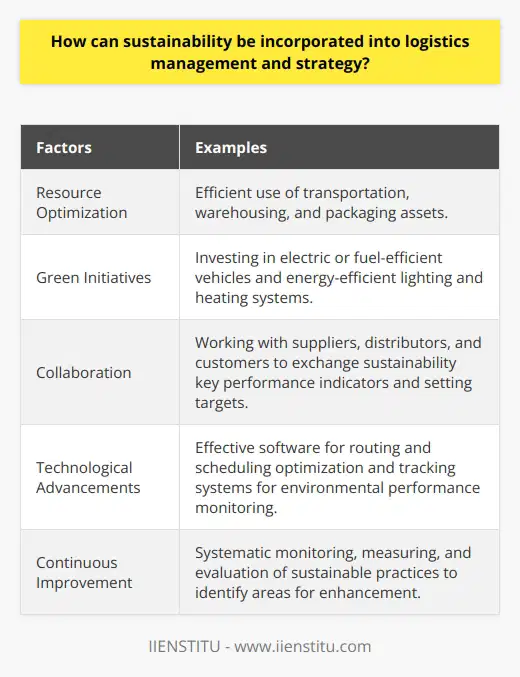
What is the role of data analysis and prediction in optimizing logistics operations?
Role of Data Analysis in Logistics Operations
The primary role of data analysis in optimizing logistics operations is to facilitate informed decision-making. By scrutinizing vast amounts of historical data, organizations can identify patterns and trends that help them improve supply chain efficiency and effectiveness. Data-driven insights can also enable companies to better understand customer behavior, preferences, and demands, which can lead to enhanced service levels and customer satisfaction.
Prediction Models and Operational Planning
Incorporating prediction models into operational planning helps logistics companies to anticipate and prepare for potential disruptions, delays, or changes in demand. Accurate forecasting ensures that organizations allocate resources effectively, improving inventory management, warehouse utilization, and transportation capacities. By identifying bottlenecks and inefficiencies, predictive analytics can further enhance the overall performance and sustainability of logistics operations.
Reducing Costs and Maximizing Profitability
Data analysis and prediction tools can play a crucial role in reducing operational costs and maximizing profitability. By analyzing costs associated with various aspects of logistics operations, such as transportation, warehousing, and labor, organizations can identify areas for potential cost savings and allocate resources more efficiently. Additionally, predictive analytics can aid in determining optimal pricing strategies and finding the perfect balance between cost reduction and customer satisfaction.
Capacity Optimization and Asset Utilization
An effective data analysis strategy can aid logistics operators in optimizing capacity and asset utilization. By analyzing historical data and real-time inputs, organizations can enhance resource allocation for warehouse operations, fleet management, and distribution networks. This ensures optimal utilization of assets by reducing idle time, freight costs, and unnecessary congestion.
Demand Forecasting and Mitigating Supply Chain Risks
Data analysis plays a pivotal role in demand forecasting and mitigating supply chain risks. Accurate demand predictions contribute to better inventory management, allowing organizations to optimize stock levels, minimize holding costs and reduce the risk of stockouts. In addition, risk modeling allows logistics companies to proactively identify potential supply chain disruptions and devise strategies to mitigate or avoid them entirely.
Data analysis and prediction techniques are indispensable tools for optimizing logistics operations. By utilizing these methods, organizations can make well-informed decisions, streamline their processes, manage risks, and ultimately, achieve a competitive edge in the fast-paced, ever-evolving world of logistics.

